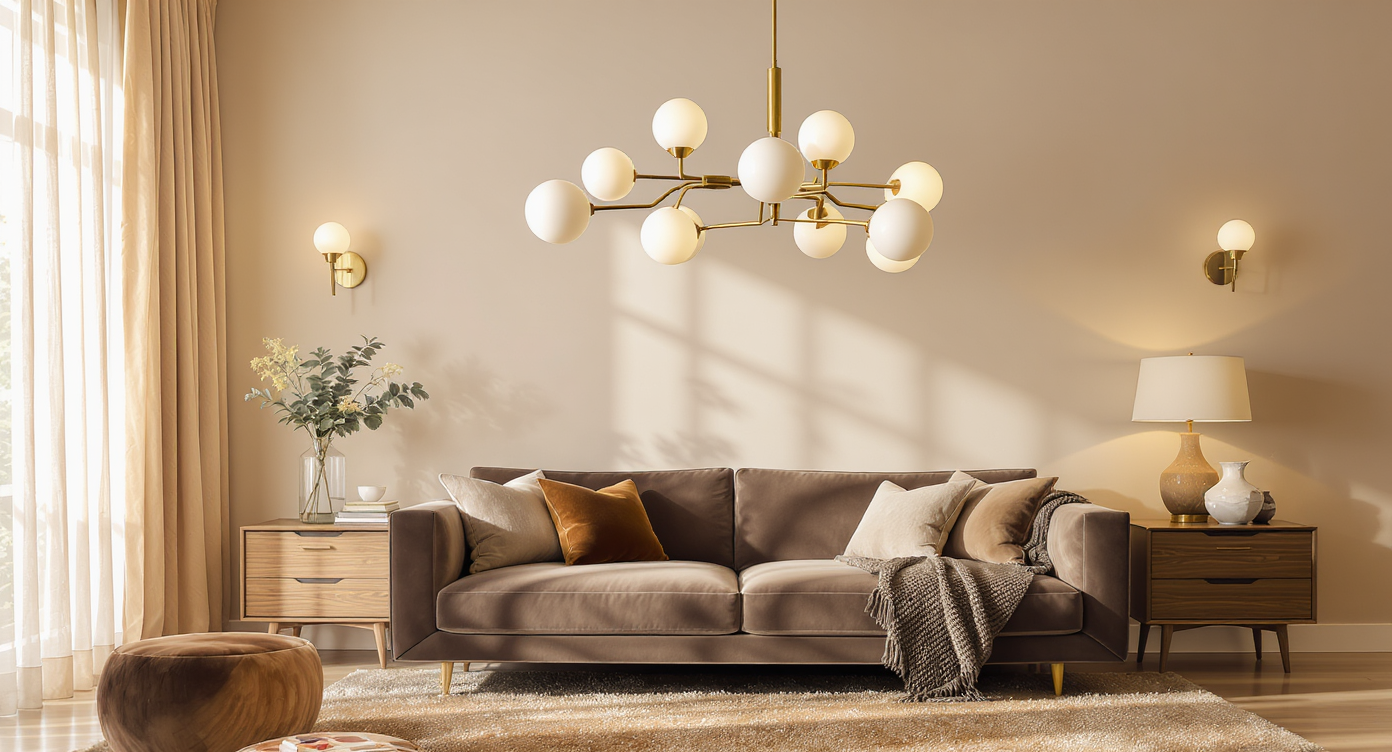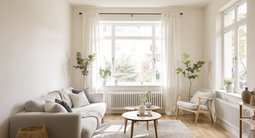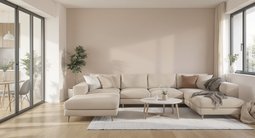TL;DR
The biggest 2026 living room lighting trend blends a sculptural chandelier with metallic accents and layered ambient, task, and accent lighting. If you’re wondering how to layer lighting in a living room, start with a statement piece, add warm dimmable bulbs, and support it with sconces and table lamps for balance and mood control.
The Mood-Making Power Of Light

Layer sculptural and metallic lighting to add warmth and depth to your living room ambiance.
2026 living room lighting is all about statement lighting, layered lighting, and metallic fixtures that add warmth and depth.
Here’s the thing: living room lighting shapes everything you feel in a space. The new direction for 2026 favors sculptural chandeliers, gleaming metallics like brushed brass or soft gold, and a thoughtful mix of light sources you can dim and tune throughout the day. It’s dramatic and inviting all at once.
Celebrity homes have accelerated this shift, with highly curated fixtures that act like sculpture. Think of a chandelier with organic arms or milk-glass globes, then support it with sleek wall sconces and low, glowing table lamps. The result is livable luxury: visually appealing, comfortable at every hour, and flattering to faces, fabrics, and art.
Your Lighting Game Plan For 2026
Layered lighting works best when you combine ambient, task, and accent light with warm, dimmable bulbs and one sculptural focal point.
Start with a focal piece. A sculptural chandelier or statement pendant becomes your ambient lighting and visual anchor. In living rooms with 8 to 9 foot ceilings, keep at least 7 feet of clearance under a chandelier; in rooms with seating beneath, hang it so the bottom sits roughly 30 to 36 inches above a coffee table.
Choose warm, flattering bulbs. For living rooms, designers often advise 2700K to 3000K color temperature and high-CRI bulbs (90+ CRI) to help colors and skin tones look natural. As a rule of thumb, aim for 10 to 20 lumens per square foot overall, layered across multiple fixtures rather than one harsh “big light.”
Add task lighting where you live. Pair sofas and chairs with table lamps or adjustable floor lamps for reading at 30 to 36 inches high. If you love conversation nooks, small-scale articulating sconces or swing-arm lamps keep light off the TV and on faces.
Place accent lights for dimension. Wall sconces centered 60 to 66 inches from the floor add height and texture; picture lights sit 5 to 7 inches above a frame. Wash millwork or stone with low-glare lights to create depth without visual clutter.
Bring in metallic fixtures for quiet glamour. Brushed brass, soft gold, or blackened bronze mix beautifully. Keep it to two or three finishes total for a cohesive layered lighting look. Metallics bounce warm light and introduce a subtle sparkle that reads as luxurious, not loud.
Use dimmers and zones. Put the chandelier, sconces, and lamps on separate dimmers so you can shift from 100 percent for cleaning, to 50 percent for guests, to 20 to 30 percent for movie night. Smart dimmers or tunable LEDs are small tweaks with big impact.
User insight: I’ve seen living rooms transform simply by swapping cool 4000K bulbs for 2700K and adding a dimmer; the same furniture suddenly feels softer, richer, and more inviting.
Anecdote
One couple insisted their chandelier belonged over the coffee table, but it hung too high and felt cold. We lowered it to give 7 feet of clearance in the walking path and added two linen-shade sconces at 62 inches. The room suddenly glowed, and their art popped. A renter I know layered a plug-in arc lamp in brushed brass with a pair of clip-on picture lights, all on smart plugs; the metal accents made the space feel custom without a single wire in the wall. A minimalist client tried smoked-glass globes over a slim black frame; with 2700K bulbs and a small brass tray on the coffee table, the glow felt warm, not fussy.
Common Mistakes To Avoid
Overhead-only lighting flattens a room and makes it feel colder and smaller; layer ambient, task, and accent light to add depth and warmth.
- Relying on one ceiling fixture. Why it happens: habit. Fix it: add two table lamps and a pair of wall sconces to create three light levels.
- Blue-white bulbs everywhere. Why it happens: assuming “brighter is better.” Fix it: use 2700K to 3000K warm bulbs in living spaces and keep CRI at 90+ for true color.
- Hanging heights that feel off. Why it happens: guessing. Fix it: keep chandelier clearance at 7 feet in circulation paths; mount sconces 60 to 66 inches to center.
- Too many metals. Why it happens: trend chasing. Fix it: cap finishes at two or three; repeat each at least twice so it looks intentional.
- Ignoring dimmers. Why it happens: “I’ll add them later.” Fix it: install dimmers now; they’re the cheapest way to make lighting feel custom and controllable.
Expert Moves To Make Your Room Sing
Aim for three to five light sources in a medium living room and put every circuit on a dimmer for precise mood control.
- Go sculptural, not just oversized. A chandelier with organic arms, sphere clusters, or folded-metal shades reads like art and reduces the need for extra decor.
- Asymmetric pairing adds interest. Try one slim floor lamp on the left of a sofa and a low ceramic table lamp on the right to balance heights and textures.
- Use beam spread wisely. A 40-degree beam on an accent light highlights art without glare; wider beams (60 to 90 degrees) bathe walls for softness.
- Try plug-in solutions. Renters can get the wall-sconce look with plug-in models and cord covers; mount centers at 62 inches to keep consistency.
- Mind reflections. If you have a TV, angle sconces and use matte bulbs or opal glass to avoid screen glare while preserving ambiance.
- Mix glass finishes. Smoked or opal glass diffuses light for a softer glow; clear glass increases sparkle but may need lower-wattage or frosted bulbs.
Reflection: Every truly great living room I visit has lighting that changes with the moment. Morning coffee, homework hour, late-night talk — one plan, multiple moods.
Tools, Ideas, And Alt-Text You Can Use
Free tools and simple practices help you plan layered lighting without guesswork.
- Use a room lumen calculator to estimate totals, then divide output across 4 to 6 fixtures instead of one.
- Mock placement with painter’s tape. Mark sconce heights at 60 to 66 inches and chandelier diameters before you buy.
- Choose smart dimmers or bulbs for scene presets: “Read 70%,” “Guests 50%,” “Movie 20%.”
- Visualize options with ReimagineHome. Upload a photo and test sculptural chandeliers, metallic fixtures, and wall sconces before committing.
Suggested image alt-text and captions:
- Alt: Sculptural brass chandelier over a neutral sofa with layered table lamps and wall sconces. Caption: Layered living room lighting with metallic finishes and warm bulbs.
- Alt: Brushed gold wall sconces flanking artwork above a console. Caption: Sconces centered at 62 inches add height and gentle accent light.
- Alt: Mixed-metal floor and table lamps beside a sectional. Caption: Two finishes repeated for a cohesive lighting palette.
Visualization Scenario
It’s just after sunset. A sculptural chandelier dims to 30 percent, its soft gold branches catching a quiet sheen. Sconces wash the wall in a gentle halo, the grain of the wood console deepening. A low ceramic lamp pools light over a book. The TV is off, the room is calm, and the light feels like a tailored blanket — warm, layered, and perfectly yours.
FAQ: Living Room Lighting Trends 2026
How should I layer lighting in a living room?
Layer ambient, task, and accent lighting: a sculptural chandelier for ambient, table or floor lamps for task, and wall sconces for accent. Put each layer on a dimmer for flexible mood control.
What’s the best bulb color temperature for living rooms?
For living room lighting, 2700K to 3000K warm white is recommended to flatter skin tones and fabrics while keeping the space cozy and inviting.
Can I mix metals in lighting fixtures in the same room?
Yes, mixing metals looks intentional when limited to two or three finishes and repeated at least twice. Brushed brass with blackened bronze is a timeless pairing.
How high should I hang a chandelier in a living room?
Maintain about 7 feet of clearance in walking paths; above a coffee table, the bottom of the fixture can sit roughly 30 to 36 inches above the tabletop.
Where should wall sconces be placed in a living room?
Mount wall sconces with the center at 60 to 66 inches from the floor and space them 5 to 8 feet apart depending on room size and the beam spread of the fixture.
Light The Room You Actually Live In
Lighting is the fastest way to change how a living room feels, and 2026 points to sculptural statements, metallic warmth, and flexible layers. Choose one showpiece chandelier, ground it with task lighting, add glowy accents, and keep everything dimmable and warm. Do that, and your space will look good at noon, feel magical at dusk, and stay comfortable long after the credits roll. Ready to test ideas risk-free? Try layouts and finishes in minutes with ReimagineHome.
.svg)

.svg)














.png)